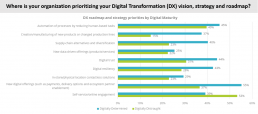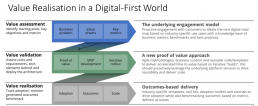We were delighted to host the third IDC Digital Leadership Think Tank of 2022 on March 31. Around 50 digital leaders from around Europe joined the call to share their challenges, successes and experiences of delivering digital transformation that can provide a genuine return on investment.
Marc Dowd and Chris Weston from the IDC Executive Advisory team were joined by Erica Spinoni from IDC’s Digital Transformation practice.
Today’s Digital Transformations
Kicking off the session, Marc Dowd asked the audience how they defined ROI against digital transformation. Our first CIO contributor explained what it meant for his business, firstly diversifying and transforming their industry, moving to other types of products and disintermediation of the sales process. Secondly, rethinking how they run their business given the opportunities afforded by new technologies, and finally how to incorporate technology in their consumer offer. The ROI of all these is clearly complex and interdependent. There are foundational steps that are needed which might not produce clear ROI on their own but are essential to take advantage of the benefits of later projects.
This sparked a lot of comments from other CIOs on the call — one talked of the more strategic use of IoT across their business that changed the way they thought about their process and the value they provide to their clients. Another spoke of a fundamental mindset change in their business, removing silos so that the digital tools are delivered by a true partnership between operations and IT.
Our next contributor, from the oil and gas industry, explained how digital transformation programmes in their company focused on how they can bring new technologies and new skillsets to bear on their market, particularly in the area of data. Various aspects of the business value and collect particular data sets but opening up the organisation allows these to be combined and compared to create even more value, first to internal stakeholders and then external.
The conversation continued, demonstrating the wide range of definitions of transformation, and both bottom- and top-line ROI. This information exchange is a fantastic example of the value of these meetings, and the inspiration that can be taken from peer conversations.
The Truth About ROI
Having discussed the definition of digital transformation, we moved onto how we measure return on investment. As mentioned earlier, individual projects may not bring immediate results but must be considered as a wider programme of transformational work, with underpinning process supporting later initiatives. Indeed, there are countless examples of technology being deployed as the next great idea only to wither away because the supporting infrastructure was not considered. One of our contributors explained that in their industry, the key outcome for digital transformation was to improve customer experience.
This presents a particular problem regarding measuring outcomes and ROI since customer behaviours are complex, but adoption and stickability were mentioned as KPIs that are used by some in the group to prove the benefit of investment. When doing this it is important to set the expected adoption rate at the start of the project, so that it can be compared further down the line.
ROI becomes even more difficult in the next scenario we discussed, which was from a CIO who described their customer experience investment as targeted at creating advocates for their products and services among their customer base. This prompted a comment from other contributors about their effort to improve the experience of employees and the brand equity of the business, helping to retain and recruit staff, or to link the digital transformation with organisational purpose. More problems with ROI definition!
Working in Partnership
Our discussion then took an interesting turn — how we partner with suppliers that can help achieve these aims. The comment was made that once upon a time we used outsourcing to drive costs down by moving commodity process to another provider, but today as digital and business outcomes are far more intertwined, we look for partners. W
e must decide what are the key skills we need in our businesses and who are the partners that can help us deliver the change, and these often have to be long-term arrangements to provide value to both sides. A DLC member from the manufacturing sector explained how they were moving from a 90% outsourced IT model to insourcing many capabilities and changing their approach to their outsource partners. This is a trend we continue to see throughout our network.
Good governance was emphasised by Chris Weston, CIO advisor at IDC. He described the idea of “cornflake management” that can often be a problem for organisations with insourced IT, where whatever idea execs have over their breakfast can become the new priority for the team. The friction that comes with outsourcing, while it can be a source of frustration, can also be a healthy deterrent to rapidly shifting priorities. Companies that insource should be aware of this phenomenon.
As the conversation drew to a close, we attempted to solve the ROI question by looking at cost versus opportunity. As the IT department evolves from being a cost centre to being the key enabler for many revenue streams, the CIO’s partnership with sales, marketing and operations becomes even more critical.
One of our members described how his IT team had rebranded and reorganised to become the digital business solutions group. This is part of changing the mindset from supplier to an integral part of the business. Another took this further with the concept of digital products which is becoming ever more common — where the evergreen nature of the process, transformation never ending and the technology evolving with customer outcomes means far more focus on opex rather than capex, which can be a challenge for some business models.
Conclusions
As we finished, it was clear that the challenge of showing ROI in many digital transformation cases is not easy and that there are many subjective benefits (or otherwise) to these changes that are difficult to measure accurately, if at all. However, as one contributor said, some of this work is essentially the investment you need to stay in business. As an industry evolves, it is not always possible to maintain old business models and ways of working. The key, as always, is to keep a strategic focus on the organisation’s objectives and the end products produced for the customer.
The IDC CIO Advisory team would like to thank everyone who came to the call for their input. It is always inspiring to hear from those making change in their business and taking the tough calls with their management colleagues. We hope this session was valuable and provided many takeaways for you.
Our second quarter sessions will look in more detail at customer/employee experience, including new trends such as the metaverse, strategies for the API enterprise, and multicloud, on premises and the question of where your workloads are most appropriately hosted. If you already receive invitations to our sessions, I hope to see you there. If you would like to join this community, please email us at mdowd@idc.com.
NEXT: IDC Digital Leadership Community Think Tank, April 28, 2022: Customer Experience, Employee Experience and the Focus on People for Digital Success.




